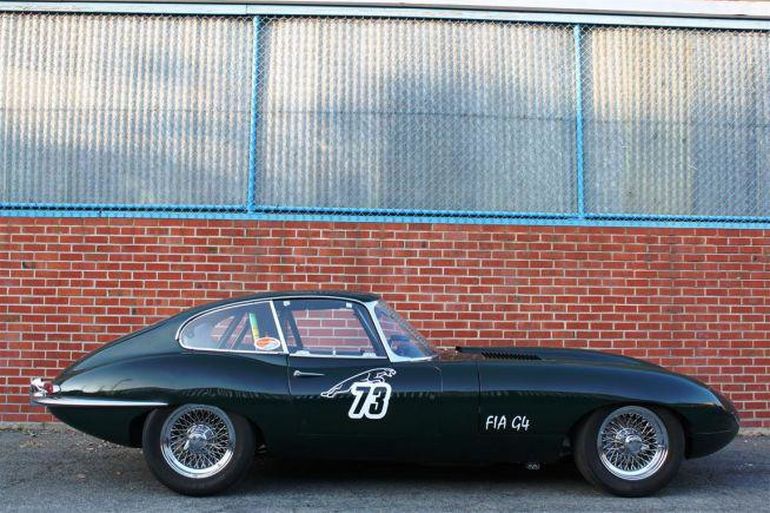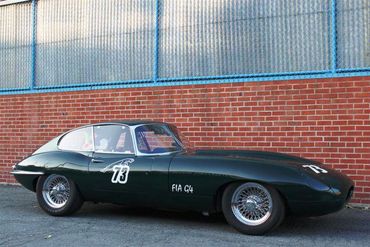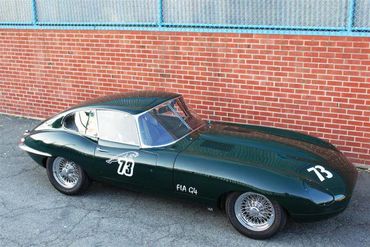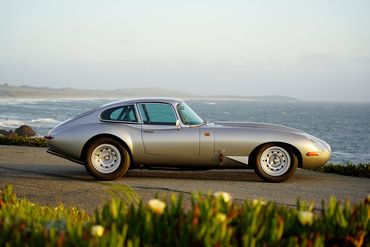Sold
SOLD 04/12
1965 Jaguar
E-Type Lightweight-Style Vintage Racecar
Rotisserie Restored, Highly Sorted Lightweight-Style E-Type For HSR, SCCA Vintage and More.
- VINE30908
- Exterior ColorBritish Racing Green
- Interior ColorNatural
- MileageTMU
- Engine4.2 Litre Inline 6-Cylinder
- Engine no.7E3551-9
- Transmission4-Speed
- StatusSold
- StockFJ1186
Description
1965 Jaguar E-Type Lightweight-Style Vintage Racecar
s/n E30908
British Racing Green with Natural Interior
Summary
• Rotisserie restoration
• 375 hp, 320 ft lbs torque
• 7000 rpm redline
• Refreshed engine with 6 hours running time
• 2350 pounds – extensive use of custom made aluminum panels
• Fully adjustable suspension front and rear as to ride height, toe, and camber
• Extensively raced on the west coast
• Well proven, quick and reliable
• Eligible for historic racing in HSR, SCCA Vintage, and many other venues
• An outstanding track toy at a fraction of the cost to build
Engine-Driveline
• Series III sedan block and big valve head, custom ported
• 12.5 : 1 compression
• Isky XM5 Cams
• Manley stainless steel valves
• Cosmetic head gasket
• Aries forged pistons
• Crower rods
• 7000 rpm redline
• Steel high speed damper
• Tilton geared starter
• GTJ aluminum racing fly wheel
• Tilton racing clutch
• Quartermaster slave cylinder
• MDS ignition with Jaguar/Lucas distributor
• GTJ oil pump and windage tray
• Accusump
Carburetion
• 3 X 45 D.C.O.E. Webers, or 3
• Carter fuel pump and regulator
Cooling
• Custom aluminum radiator with a water/oil intercooler installed (not currently in use)
Exhaust
• Custom header style, 3 into 1 in the fashion in which they were done in the 60’s
• Burns stainless steel lightweight muffler (has passed a 95db test)
Suspension
Front
• Lowered upper control arm pick up points
• Custom made steering arm (to remove bump steer)
• 7/8” sway bar
• Leda double adjustable shocks
• .92 torsion bar with external adjustment for ride height
Rear
• customized lower control arm to permit adjustments for toe-in and simplified camber adjustments
• The stock trailing arm has been removed and replaced with a semi trailing arm set up
• Single Leda shock and coil per side
Brakes
• Front Ser III E Type with Jaguar ventilated rotor
• Rear Aftermarket calipers with ventilated rotorss54 (Coleman)
Body
• Rotisserie restoration
• 8 point roll cage
• 10 pound built-in Halon fire extinguisher
• Fuel Safe cell
• Lexan windscreen and all windows
• Custom aluminum rear hatch
• Drilled and lightened driver’s door and hinge
• Passenger door is a doorskin attached with quick release fasteners
• Aluminum trunk floor installed with aircraft rivets
• All internal bonnet baffles, custom aluminum
• Kirkey racing seat, fully upholstered
Wheels and Tires
• Dayton chrome wire wheels ( well laced ) 15 x 7
• Hoosier 225/55 – 15 tires
Weight
• 2350 pounds wet (half tank)
• Approximate 50-50 balance with driver
RACING PREPERATION
To race this car you will need to change all the fluids. The car has fresh antifreeze in the cooling system for transportation– most tracks do not permit this. The oil in the engine is ordinary motor oil, the brake fluid is Dot 3, the fuel in the tank is premium, and the tires need replacing. I use the following:
• Synthetic racing oil of at least 40 weight
• Brake fluid with a boiling point of 500 f., which should be changed frequently
• Racing fuel of at least 112 octane
CAR SETUP
I’ve done extensive variations of the car’s set up to arrive at what suits me for handling. I like a car that is mostly neutral, and that is what this car is. It uses .92 front torsion bars which is the thickest that can be used easily. The sway bar is 7/8” in the front with no bar in the rear. The rear uses as I recall single springs of 825 pounds/inch. The single spring concept is widely used in England in racing E types and is done to save weight. The Leda shock absorbers are English racing shocks and are fully adjustable for jounce and rebound control (double adjustable) with a single knob. The rear shocks are calibrated by the factory to be single shocks per side. I usually run with the shocks set at half way between full hard and soft.
I’ve included a larger hollow sway bay for the front. I’ve run the car with this bar and it is considerably stiffer than the current bar. If you want to use it you will need to add stiffness to the rear of the car, either by heavier springs or by using a sway bar, as the larger bar alone causes the car to understeer.
SUSPENSION SETTINGS
Again I’ve tried many settings and combination of settings, and have found the following works best with the radial tires I’ve always run:
Front:
Zero toe, 1-2 degrees negative camber. The car currently has a lot of positive castor because I prefer strong self centering of the steering wheel. The front suspension has upper pick up points that are lowered from stock. This was standard racing practice from the factory in the 1960’s. (See Phillip Porter’s book: “E Type The Definitive History”) This change necessitates modified steering arms which are custom made to raise the point where the steering connects to it. (An alternative to this is to lower the steering rack and use stock arms)This is done to eliminate bump steer. The purpose of dropping the upper pick up points is to induce greater negative camber into the outside wheel in a turn, as the car rolls into it, and positive camber into the inside wheel at the same time. As a result: you do not need a lot of negative camber at static settings in the front, as the car gains negative camber in the turns. Static negative camber exceeding 2 degrees is noticeable as increasing understeer. Similarly stiffer sway bars defeat these camber gains as they restrict roll. If you stiffen the car you will need more static negative camber.
I’ve got extensive experience in modifying E Types. These changes to the front suspension, along with the camber settings recommended add 2 seconds on a two minute lap, with no detrimental side effects. An additional benefit is that the tire is more upright in braking, giving a larger contact patch.
Rear
The rear suspension has been modified to be a semi trailing arm suspension, from the fully trailing arm set up from the factory. This is a standard E Type racing mod. I suspect that it doesn’t make a lot of difference to the cars handling. The rear suspension mounts are hard rubber. I’ve heard reports that solidly mounted rears will cause cracking in the body channels to which they are mounted. There is an arm connecting the lower cage to the chassis to prevent the cage from pivoting. That combined with the triangulation of the semi trailing arms will locate the cage. Camber setting is 3 degrees negative. (Hoosier recommends this setting) My experience is that this works best. Going beyond this will result in the car running on the inside of the tire and will cause that portion of the tire to overheat. Again from experience, it is definitely slower. The lower control arms are modified to permit toe in. This modification was not done to permit camber adjustment as that is done by shimming the half shaft. Jaguar found when racing that the introduction of toe in helped high speed stability. (See Porters book again) I run the car with 5/16” toe in at the rear.
BRAKES
I ran the car for many years with Willwood aluminum calipers on the front, and I’ve included these with the car. I’ve changed the front calipers to Ser III E type calipers, and rotors (10.5”), as most vintage racing clubs outlaw aluminum brakes. I’ve not run the car with these brakes, but this is a standard modification to the cars when racing so I know that it will work. You will have to experiment with brake balance as it will probably have changed. There is a brake bias adjuster in front of the master cylinder. Currently the front brakes have stock Ser III pads, but I’ve included some Hawke completion pads. If you are running the car in slaloms hill climbs which do not heat up the brakes use the stock pads.
ENGINE TUNING
This engine has been on an engine dyno, but as of writing this I am unable to find the sheets. I’ve done extensive dyno work of XK engines over the years. This engine with the Webbers and the current exhaust system produces approximately 375 bhp at about 5700 rpm, and a very flat torque curve at 320 pd/ft. This is consistent with other XK engines with similar modifications. The red line is 7000 rpm, but as power drops off over 6000 rpm I go to redline only on the straights that need it. Like all hemi’s this engine is prone to detonation, so you need to be careful with octane ratings and timing. The car runs a stock Lucas distributor with heavier springs to slow full mechanical advance to a higher rpm. Many racers remove the mechanical advance mechanism, but I don’t recommend this for this car because it will detonate at lower rpm at full advance. Full advance is 34 degrees. Dyno testing on these engines has revealed the following points:
• Like other hemi’s it has a lazy flame front, and wants a lot of advance. On other lower compression XK engines I’ve run up to 40 degrees total advance for significant power gains. You need however to be careful here.
• The engines produce the most power at richer settings.
• The engine produces the most power with a water temperature of 180 degrees f. Hotter reduces power.
This engine runs without a thermostat, but with a partial blanking plate to increase water pressure in the block. It runs at 180 degrees even on very hot days. The water pump is a Ser III sedan pump which is bigger that stock. The notches in the water pump pulley allow you to access the bolts that hold the water pump to the block, as you can’t remove the pulley with the pump in the car.
Oil temp is 220 -230 degrees so synthetic oil is necessary. The radiator has a built in water/oil intercooler which is currently not in use. The oil filter is a stock Ser II or Ser III sedan filter. Oil pressure is regulated by a pressure relief valve on the custom oil pump in the pan, accessible through the large blue plug on the left side of the oil pan. It is set for 80 psi hot.
I run a Fidenza custom windage tray in the oil pan. This is very good at controlling the oil, but under heavy braking at the end of a long straight the oil pressure warning light above the dash will flicker. This is triggered at 40 psi, so there is still a lot of pressure. As well the Accusump will provide several seconds of oil pressure. The car would benefit from a dry sump. It doesn’t have one because the local rules until recently prohibited them on production cars.
The alternator is a GM product that is out of the smallest GM car – so the output is the lowest available. This isn’t the smallest alternator, but it is the lightest (I’ve weighed them all including the small Nippon Denso’s). It has a larger than stock pulley for slower speeds. The battery is out of a golf cart, and will last through a typical weekend racing. I recommend starting the car by using the jumper cables supplied.
POWERTRAIN
Flywheel is a Fidanza aluminum racing flywheel. The clutch is a 7.25 double plate Tilton Rallye Pack, with a Quartermaster slave cylinder. The clutch is not suitable for street driving. Transmission is a stock E Type four speed. The differential is a stock Jaguar unit with a 3:56 ratio. It uses a heavy duty Dana clutch pack for the limited slip.
Eligible for historic racing in HSR, SCCA Vintage, and many other venues around the world. An outstanding track toy at a fraction of the cost to build.
Detailed information courtesy of the owner.
The above vehicle information is complete and accurate to the best of our knowledge at the time it is posted to this website. Corrections or additional information is always appreciated. All advertised prices exclude government fees and taxes, any finance charges, any dealer document preparation charge, and any emission testing charge. Vehicles are subject to prior sale. All advertised to be true but not guaranteed. We assume no liability for errors or omissions.
Inquire About This Car
Fantasy Junction • 510-653-7555 • 1145 Park Ave, Emeryville, CA 94608




